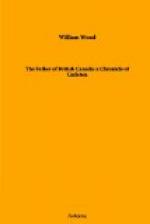Montgomery and Arnold had about the same total number of men. Sometimes there were more, sometimes less. But what made the real difference, and what really turned the scale, was that the Americans had hardly any regulars and that their effectives rarely averaged three-quarters of their total strength. The balance was also against them in the matter of armament. For, though Morgan’s Virginians had many more rifles than were to be found among the British, the Americans in general were not so well off for bayonets and not so well able to use those they had; while the artillery odds were still more against them. Carleton’s artillery was not of the best. But it was better than that of the Americans. He decidedly overmatched them in the combined strength of all kinds of ordnance—cannons, carronades, howitzers, mortars, and swivels. Cannons and howitzers fired shot and shell at any range up to the limit then reached, between two and three miles. Carronades were on the principle of a gigantic shotgun, firing masses of bullets with great effect at very short ranges—less than that of a long musket-shot, then reckoned at two hundred yards. The biggest mortars threw 13-inch 224-lb shells to a great distance. But their main use was for high-angle fire, such as that from the suburb of St Roch under the walls of Quebec. Swivels were the smallest kind of ordnance, firing one-, two-, or three-pound balls at short or medium ranges. They were used at convenient points to stop rushes, much like modern machine-guns.
Thanks chiefly to Cramahe, the defences were not nearly so ‘ruinous’ as Arnold at first had thought them. The walls, however useless against the best siege artillery, were formidable enough against irregular troops and makeshift batteries; while the warehouses and shipping in the Lower Town were protected by two stockades, one straight under Cape Diamond, the other at the corner where the Lower Town turns into the valley of the St Charles. The first was called the Pres-de-Ville, the second the Sault-au-Matelot. The shipping was open to bombardment from the Levis shore. But the Americans had no guns to spare for this till April.




